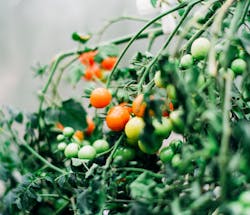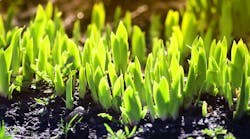Wageningen University & Research (WUR) has its second Autonomous Greenhouse Challenge underway in Bleiswijk, the Netherlands. Five teams are competing to use LED lighting and a bevy of their own technology to remotely manage a greenhouse growing cherry tomatoes. The contest will end in May and winners are scheduled to be announced at the Greentech 2020 event slated for June 8–10 in Amsterdam.
The challenge caught our eye because of the applicability of LED lighting and other technologies to automate the growing process. Such developments are a focus of our HortiCann Light + Tech Conference scheduled for Oct. 20 in San Jose, CA. Research is demonstrating that you can use dynamically-controlled spectra to optimize plant growth and that autonomous control of the growing environment along with real-time feedback of plant conditions can further optimize yield.
WUR provided each of the teams with greenhouse space. Heliospectra is one of the sponsors of the program, and supplied the teams with Elxia four-channel LED fixtures, and the company’s helioCORE control platform. The Elixia lighting is a supplement to high-pressure sodium (HPS) lighting already installed in each of the greenhouses.
The teams equipped their greenhouses with additional technology to make remote management of the greenhouses feasible with what WUR described as minimum manual intervention. The teams were able to install cameras and sensors of their choice and develop their own control scenarios including the use of artificial intelligence (AI) to optimize the growing operation over the six-month period of the contest. The teams also had the freedom to develop their own communications and IT systems to enable a successful challenge.
The five participating teams include:
- AICU: Staff, researchers and students from Wageningen University, Evertill Agricultural Co., IGMPR Flower, NXP Semiconductors, Parks & More, Ibeo Automotive, Amsterdam UMC, CGI, Rotterdam.AI, and Port of Rotterdam-Fordata.
- DIGILOG: Employees, researchers, and students from A-net, Hankyong National University, Seoul National University, University of Liege, Samsung Electronics, EZFarm, FARM8, Spacewalk, and ioCrops.
- IUA.CAAS: Employees, researchers, and students from the Chinese Academy of Agricultural Sciences (CAAS), the Chinese National Agricultural Science & Technology Center, the Chinese National Engineering Research Center for Information Technology in Agriculture, Sichuan Film and Television University, Syngenta Seeds B.V. Lushan Botanical Garden, Ghent University, LIVO, and Agro Care.
- The Automators: Staff and students from Delphy, Wageningen University, and 30 MHz.
- Automatoes: Employees, researchers, and students from Van der Hoeven Horticultural Projects, Delft University of Technology, Keygene, and Hoogendoorn Growth Management.
The challenge was purposefully scheduled for what were mostly winter months during which the supplemental lighting would have been most impactful. A larger group of 21 teams had competed in an initial challenge involving cucumbers back in 2018. The set of teams for the current competition was then trimmed to five during what WUR called a Tomato Hackathon in September 2019.
We have covered aspects of technology beyond LED lighting in our articles on presentations made first at our Horticultural Lighting Conferences and then last year at the rebranded HortiCann event. For example, at the 2017 event we learned about the use of an imaging sensor or camera to discern what a plant needs dynamically. Last fall, we wrote more about integrated technology for horticulture. Expect speakers at the 2020 event to dig even deeper.





